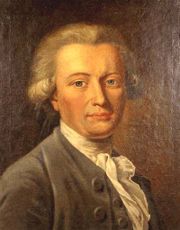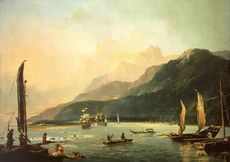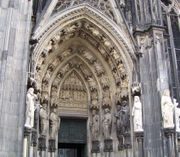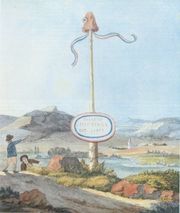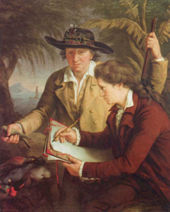Georg Forster
2007 Schools Wikipedia Selection. Related subjects: Human Scientists
Johann Georg Adam Forster ( November 27, 1754 – January 10, 1794) was a German naturalist, ethnologist, travel writer, journalist, and revolutionary. At an early age, he accompanied his father on several scientific expeditions, including James Cook's second voyage to the Pacific. His report from that journey, A Voyage Round the World, contributed significantly to the ethnology of the people of Polynesia and remains a respected work among both scientists and ordinary readers. As a result of the report Forster was admitted to the Royal Society at the early age of twenty-two and came to be considered one of the founders of modern scientific travel literature.
After his return to continental Europe, Forster turned towards academics. From 1778 to 1784 he taught natural history at the Collegium Carolinum in Kassel and continued later at Academy of Vilna (1784-1787) until he accepted the position of head librarian at the University of Mainz in 1788. Most of his scientific work during this time consisted of essays on botany and ethnology, but he also prefaced and translated many books about travels and explorations, including a German translation of Cook's diaries.
Forster was a central figure of the Enlightenment in Germany, and corresponded with most of its adherents, including Georg Christoph Lichtenberg, who was a close friend of his. His ideas and personality influenced strongly one of the greatest German scientists of the 19th century, Alexander von Humboldt. When the French took control of Mainz in 1792, Forster became one of the founders of the Jacobin Club there and went on to play a leading role in the Mainz Republic, the earliest republican state in Germany. During July 1793 and while he was in Paris as a delegate of the young Mainz Republic, Prussian and Austrian coalition forces regained control of the city and Forster was declared an outlaw. Unable to return to Germany and separated from his friends and family, he died in Paris of illness in early 1794.
Early life
Forster was born in the small village of Nassenhuben ( Polish: Mokry Dwór) near Danzig (Gdańsk), in the Polish province of Royal Prussia.
He was the oldest of seven surviving children of Johann Reinhold Forster and Justina Elisabeth (née Nicolai). His father was a naturalist, scientist and a Reformed pastor. In 1765, the Russian tsarina Catherine II gave the pastor an assignment to travel in Russia on a research journey and investigate the situation of a German colony at the Volga River. Georg, then ten years old, joined him. They reached the Kirghiz steppe at the lower Volga. On the journey, they discovered several new species. The young Forster learned there how to conduct scientific research and how to practise cartography. He also became fluent in Russian.
The report from this journey, which included sharp criticism of the governor of Saratov, was not well-received at the court, and the Forsters did not obtain fair payment for their work and had to move house. They chose to settle in England in 1766. The father took up teaching at the Dissenter's Academy in Warrington and also translation work. The young Forster, only thirteen years old, published his first book: an English translation of Lomonosov's history of Russia, which was well-received in scientific circles.
Around the world with Captain Cook
In 1772, Forster's father Johann became a member of the Royal Society. This and the withdrawal of Joseph Banks resulted in his invitation by the British admiralty to join James Cook's second expedition to the Pacific (1772–1775). Georg Forster joined his father in the expedition again and was appointed as a draughtsman to his father. Johann Forster's task was to work on a scientific report from the journey that was to be published after their return.
They embarked on the HMS Resolution on July 13, 1772 in Plymouth. The route led first to the South Atlantic, then through the Indian Ocean and the Southern Ocean to the island of Polynesia and finally around Cape Horn back to England, where the expedition arrived on July 30, 1775. During the three-year journey, the explorers visited New Zealand, the Tonga islands, New Caledonia, Tahiti, the Marquesas Islands and Easter Island. They went further south than anybody before them, almost discovering Antarctica. The journey conclusively disproved the Terra Australis Incognita theory, which claimed there was a big, habitable continent in the South.
Supervised by his father, Georg Forster first took up the studies of zoology and botanics of the southern seas, mostly by drawing animals and plants. However, Georg also pursued his own interests which led to completely independent explorations in comparative geography and ethnology. He quickly learned the languages of the Polynesian islands. His reports on the people of Polynesia are approved even to this day, as they show Forster's endeavours to describe the habitants of the southern islands with empathy, sympathy and largely without Western or Christian prejudices.
Unlike Louis Antoine de Bougainville, whose reports from a journey to Tahiti a few years earlier had initiated uncritical noble savage romanticism, Forster had a very sophisticated picture of the societies of the south Pacific islands. He described various social structures and religions that he encountered on the Society Islands, the Easter Island and in Tonga and New Zealand, and ascribed this diversity to the difference in living conditions of these people. At the same time he also observed that the languages of these fairly widely-scattered islands are quite similar. About the habitants of the Nomuka islands (in the Ha'apai island group of present-day Tonga), he wrote that their languages, vehicles, weapons, furniture, clothes, tattoos, style of beard, in short all of their being matched perfectly with what he had already seen while studying tribes on Tongatapu. However, he wrote, "we could not observe any subordination among them, though this had strongly characterised the natives of Tonga-Tabboo, who seemed to descend even to servility in their obeisance to the king."
The ethnographical items that were collected by Georg and Reinhold Forster are currently presented as the Cook-Forster-Sammlung (Cook-Forster Collection) in the Sammlung für Völkerkunde anthropological collection in Göttingen. Another collection of items collected by the Forsters is on display at the Pitt Rivers Museum in Oxford.
The journey was rich in scientific results. However, the relations between the Forsters and Captain Cook and his officers were often problematic, both due to the elder Forster's fractious temperament and Cook's refusal to allow more time for botanizing and other scientific observation. Cook refused scientists on his third journey after his experiences with the Forsters.
A founder of modern travel literature
These conflicts continued after the journey when the problem of who should write the official account of the travels arose. Lord Sandwich, although willing to pay the promised money, was irritated with Johann Reinhold Forster's opening chapter and tried to establish an editor over him. However, Forster did not want to have his writing corrected "like a theme of a School-boy," and stubbornly refused any compromise in this direction. As a result, the official account was written by Cook, and the Forsters were deprived of the right to compile the account and did not obtain payment for their work. During the negotiations, the younger Forster decided to release an unofficial account of the travel. In 1777, the book A Voyage round the World in His Britannic Majesty's Sloop Resolution, Commanded by Capt. James Cook, during the Years, 1772, 3, 4, and 5 was published. This report was the first account of Cook's second voyage (it appeared six weeks before the official publication) and was intended for the general public. The English version and his own translation to German (published 1778-1780) earned the young author real fame. The poet Christoph Martin Wieland praised the book as the most important one of his time, and even today it remains one of the most important journey descriptions ever written. The book also had a significant impact on German literature, culture and science. For instance, Alexander von Humboldt was under its great influence and it inspired many ethnologists of later times.
Forster wrote well-polished German prose, which was not only scientifically accurate and objective, but also exciting and easy to read. His work was distinguished from conventional travel literature in so far as it did not just present a mere collection of data, instead demonstrating coherent, colourful and reliable ethnographical facts that resulted from detailed and sympathetic observation. He often interrupted the description to enrich it with philosophical remarks about the observations. His main focus was always on the people he encountered: their behaviour, their customs, habits, religions and forms of social organisation. In A Voyage round the World he even presented the songs sung by the people of Polynesia, complete with lyrics and notation. The book is one of the most important sources concerning the societies of the Southern Pacific from the times before European influence had become significant there.
Both Forsters also published descriptions of their South Pacific travels in the Magazin von merkwürdigen neuen Reisebeschreibungen ("Magazine of strange new travel accounts") in Berlin, and Georg published a translation of "A Voyage to the South Sea, by Lieutenant William Bligh, London 1792" in 1791-1793.
Forster at universities
The publication of A Voyage round the World brought Forster scientific recognition all over Europe. The respectable Royal Society nominated him as a member on 1777- 01-09 although he was not even 23 years old. He was granted similar titles from Academies ranging from Berlin to Madrid. These achievements did not give him money though. In 1778, he went to Germany to take a teaching position as a Natural History professor at the Collegium Carolinum in Kassel, where he met Therese Heyne, a classical philologist's daughter. She later became one of the first independent female writers in Germany. They married in 1785 (which was after he left Kassel) and had three children, but their marriage was not happy. From the time in Kassel on, Forster was in active correspondence with important figures of the Enlightenment, including Lessing, Herder, Wieland and Goethe. He also initiated cooperation between the Carolinum in Kassel and the University of Göttingen where his friend Georg Christoph Lichtenberg worked. Together, they founded and published the scientific and literary journal Göttingisches Magazin der Wissenschaften und Litteratur. Forster's closest friend, Samuel Thomas von Sömmering, arrived in Kassel shortly after Forster, and both were soon involved with the Rosicrucians in Kassel.
However, by 1783 Forster saw that his involvement with the Rosicrucians not only led him away from real science, but also deeper into debt (he had never been very good at managing his own expenses); for these reason Forster was happy to accept a proposal by the Polish Komisja Edukacji Narodowej (Commission of National Education) and became Chair of Natural History at Vilnius University in 1784. Initially, he was accepted well in Vilnius, but he felt more and more isolated with time. Most of his contacts were still with scientists in Germany; especially notable is his dispute with Immanuel Kant about the definition of race. In 1785, Forster travelled to Halle where he submitted his thesis about the plants of the South Pacific for a doctorate in medicine. Back in Vilnius, Forster's ambitions to build a real natural history scientific centre could not get appropriate financial support from the Polish authorities. Moreover, his famous speech on natural history in 1785 went almost unnoticed and was not printed until 1843. These events led to high tensions between him and the local community. Eventually, he broke the contract six years short of its completion as Catherine II of Russia had given him an offer to take part in a journey around the world for a high honorarium and a position as a professor in Saint Petersburg. This resulted in a conflict between Forster and the influential Polish scientist Jędrzej Śniadecki. However, the Russian proposal was withdrawn and Forster left Vilnius. He then settled in Mainz, where he became head librarian of the University of Mainz, a position his friend Johannes von Müller had held before, who made sure Forster would succeed him when Müller moved to the administration of Elector Friedrich Karl Josef von Erthal.
Forster regularly published essays on the scientific and discovery expeditions of his times and continued to be a very prolific translator; for instance, he wrote about Cook's third journey to the South Pacific, and about the Bounty expedition, as well as translating Cook's and Bligh's diaries from these journeys into German. From his London years, Forster was in contact with the private scholar Sir Joseph Banks, the initiator of the Bounty expedition and a participant in Cook's first journey.
Another field of his interest was indology (One of the main goals of his failed expedition to be financed by Catherine II had been to reach India). He translated the Sanskrit play Shakuntala using a Latin version provided by Sir William Jones: this strongly influenced Herder and triggered German interest in the culture of India.
Views from the Lower Rhine
In the spring of 1790, Forster and the young Alexander von Humboldt started from Mainz on a long journey through the Southern Netherlands, Holland, and England, which eventually finished in Paris. The impressions from the journey were described in a three volume publication Ansichten vom Niederrhein, von Brabant, Flandern, Holland, England und Frankreich im April, Mai und Juni 1790 (Views of the Lower Rhine, from Brabant, Flanders, Holland, England, and France in April, May and June 1790), published 1791-1794. Goethe said about the book: "One wants, after one has finished reading, to start it over, and wishes to travel with such a good and knowledgeable observer." The book includes considerations in the field of the history of art that were as influential for the discipline as A Voyage round the world was for ethnology. Forster belongs, for example, to the first writers who gave just treatment to the Gothic architecture of Cologne Cathedral, which was widely perceived as "barbarian" at that time.
Forster's main interest, however, was again focused on the social behaviour of people, as 15 years earlier in the Pacific. The national uprisings in Flanders and Brabant and of course the revolution in France sparked his curiosity. The journey through these regions, together with the Netherlands and England, where citizens' freedoms were equally well developed, in the end helped him to sort out his own political judgements. From that time on he started to be a confident opponent of the ancien régime. Similarly to other German scholars, he welcomed the outbreak of the revolution as a clear consequence of the Enlightenment. As early as July 30, 1789, shortly after he heard about the Storming of the Bastille, he wrote to his father-in-law, philologist Christian Gottlob Heyne that it was beautiful to see what philosophy had nurtured in people's minds and then had realized in the state. To educate people about their rights in this way, he wrote, was after all the surest way; the rest would then result as if by itself.
Life as a revolutionary
Foundation of the Mainz Republic
The French revolutionary army under General Custine gained control over Mainz on October 21, 1792. Two days later, Georg Forster joined others in establishing a Jacobin Club called "Freunde der Freiheit und Gleichheit" ("Friends of Freedom and Equality") in the Electoral Palace. From early 1793 he was actively involved in organizing the Mainz Republic. This first republic located on German soil was constituted on the principles of democracy, and encompassed areas on the left bank of the Rhine between Landau and Bingen. Forster became vice-president of the republic's temporary administration and a candidate in the elections to the local parliament, the Rheinisch-Deutscher Nationalkonvent (Rhenish-German National Convention). From January to March of 1793, he was an editor of Die neue Mainzer Zeitung oder Der Volksfreund (The new Mainz newspaper or The People's Friend). In his first article he wrote:
| Die Pressefreiheit herrscht endlich innerhalb dieser Mauern, wo die Buchdruckerpresse erfunden ward. |
("The freedom of the press finally reigns within these walls where the printing press was invented.) The freedom did not last too long, though. The Mainz Republic existed only until the retreat of the French troops in July 1793 after the Siege of Mainz.
Forster was not present in Mainz during the siege. As representatives of the Mainz National Convention, he and Adam Lux had been sent to Paris to apply for Mainz — which was unable to exist as an independent state — to become a part of the French Republic. The application was accepted, but had no effect, since Mainz was conquered by Prussian and Austrian troops, and the old order was restored.
Death in revolutionary Paris
Based on a decree by Emperor Francis II inflicting punishments on German subjects who collaborated with the French revolutionary government, Forster was declared an outlaw in the name of the Emperor (under the Reichsacht), a prize of 100 ducats was set on his head and he could not return to Germany. Devoid of all means of making a living and without his wife, who had stayed in Mainz with their children and her later husband Ludwig Ferdinand Huber, he remained in Paris. At this point the revolution in Paris had entered the stage of the Reign of Terror introduced by the Committee of Public Safety under the rule of Maximilien Robespierre. Forster had the opportunity to experience the difference between the promises of the revolution of happiness for all and its cruel practice. In contrast to many other German supporters of the revolution, like for instance Friedrich Schiller, Forster did not turn back from his revolutionary ideals under the pressure of the terror regime. He viewed the events in France as a force of nature which could not be slowed down and which had to release its own energies to avoid being even more destructive.
Yet before the reign of terror reached its climax, Georg Forster died of a stroke after a rheumatic illness in his small attic apartment at Rue des Moulins in Paris in January 1794, at the age of 39.
Views on nations and their culture
Forster had partial Scottish roots and was born in Polish Royal Prussia. He worked in Russia, England, Poland and in several German countries of his times. Finally, he finished his life in France. He worked in different milieus and travelled a lot from his youth on. It was his view that this, together with his scientific upbringing based on the principles of the Enlightenment, gave him a wide perspective on different ethnic and national communities:
| All peoples of the earth have equal claims to my good will..., and my praise and blame are independent of national prejudice. |
In his opinion all human beings have the same abilities with regard to reason, feelings and imagination, but these basic ingredients are used in different ways and in different environments, which gives rise to different cultures and civilisations. According to him it is obvious that the culture on Tierra del Fuego is at a lower level of development than the European culture, but he also admits that the conditions of life there are much more difficult and this gives people very little chance to develop a higher culture. Based on these opinions he was classified as one of the main examples of 18th century German cosmopolitanism.
In contrast to the attitude expressed in these writings and to his Enlightenment background, he used insulting terms expressing prejudices against Poles in his private letters during his stay in Vilnius and in a diary from the journey through Poland, but he never published any manifestation of this attitude. These insults only became known after his death, when his private correspondence and diaries were released to the public. Since Forster's published descriptions of other nations were seen as impartial scientific observations, Forster's disparaging description of Poland in his letters and diaries was often taken at face value in Imperial and Nazi Germany, where it was used as a means of science-based support for a purported German superiority. The spreading of the "Polnische Wirtschaft" (Polish economy) stereotype is most likely due to the influence of his letters.
Forster's attitude brought him into conflict with people of different nations he encountered and made him welcome nowhere, as he was too revolutionary and antinational for Germans, proud and opposing in his dealings with Englishmen, too unconcerned about Polish science for Poles, and too insignificant politically and ignored while in France.
Heritage
After Forster's death his works were mostly forgotten, except in professional circles. This was partly due to his involvement in the French revolution. However, his reception changed with the politics of the times, with different periods focusing on different parts of his work. In the period of rising nationalism after the Napoleonic times he was regarded in Germany as a "traitor to his country", overshadowing the perception of his work as an author and scientist. This attitude rose even though the philosopher Friedrich Schlegel wrote about Forster at the beginning of 19th century:
| Among all those authors of prose who are justified in laying claims to a place in the ranks of German classics, none breathes the spirit of free progress more than Georg Forster. |
Some interest in Forster's life and revolutionary actions was revived in the context of the liberal sentiments leading up to the 1848 revolution.
Remembering Forster was ostracised in the Germany of Wilhelm II and more so in the Third Reich, where interest in Forster was limited to his stance on Poland from his private letters. Later, the GDR, in turn, tried to profit from his memory by connecting him to its tradition as a scientist and revolutionary. For instance, the GDR research station in Antarctica that was opened on 1987- 10-25 was named after Forster. In West Germany, the search for democratic traditions in German history also lead to a more diversified picture of him in the 1970s. A scholarship program of the Alexander von Humboldt foundation for foreign scholars from developing countries is named after him. His reputation as one of first and most outstanding German ethnologists is indisputable, and his works are seen as crucial in the development of ethnology in Germany into a separate branch of science.
Works
- A Voyage round the World in His Britannic Majesty's Sloop Resolution, Commanded by Capt. James Cook, during the Years, 1772, 3, 4, and 5 (1777)
- Journal of travels in Poland (August-November, 1784), The Warsaw Voice, 1990 31 8-9
- Dissertatio botanico-medica de plantis esculentis insularum oceani Australis (1785)
- Essays on the moral and natural geography, natural history and phylosophy (1789-1797)
- Views of the Lower Rhine, Brabant, Flanders (three volumes, 1791-1794)
- Letters (posthumous compilation of his correspondence, 1828)
- Werke in vier Bänden, Gerhard Steiner (editor). Leipzig 1971
- Ansichten vom Niederrhein, Gerhard Steiner (editor). Frankfurt am Main: Insel, 1989. ISBN 3-458-32836-X
- Reise um die Welt, Gerhard Steiner (editor). Frankfurt am Main: Insel, 1983. ISBN 3-458-32457-7
- Über die Beziehung der Staatskunst auf das Glück der Menschheit und andere Schriften, Wolfgang Rödel (editor). Frankfurt am Main: Insel, 1966. – A little collection of political essays, notes, and speeches of republican thinkers and writers.
- Georg Forsters Werke, Sämtliche Schriften, Tagebücher, Briefe, Deutschen Akademie der Wissenschaften zu Berlin, G. Steiner et al. Berlin: Akademie 1958
- Georg Forster, Revolutions-Briefe, Kurt Kersten, Athenaeum Verlag, 1981
